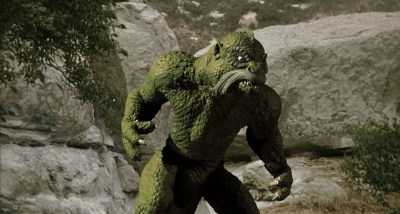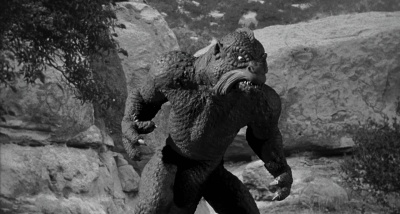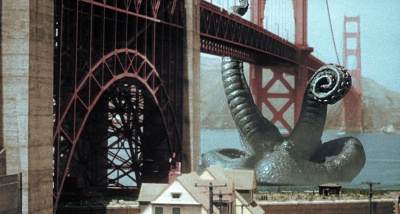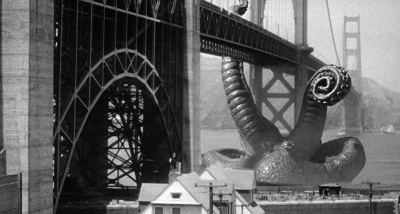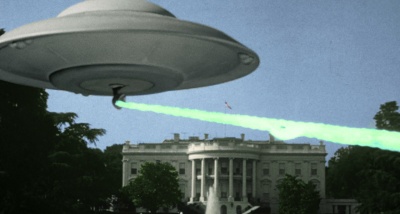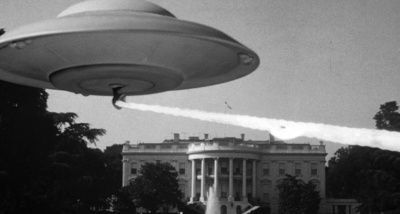| Reviews & Columns |
|
Reviews DVD TV on DVD Blu-ray 4K UHD International DVDs In Theaters Reviews by Studio Video Games Features Collector Series DVDs Easter Egg Database Interviews DVD Talk Radio Feature Articles Columns Anime Talk DVD Savant Horror DVDs The M.O.D. Squad Art House HD Talk Silent DVD
|
DVD Talk Forum |
|
|
| Resources |
|
DVD Price Search Customer Service #'s RCE Info Links |
|
Columns
|
|
|
Ray Harryhausen Collection, The
Sony Pictures // Unrated // October 7, 2008 // Region 0
List Price: $107.95 [Buy now and save at Amazon]
I've been
fortunate enough to make the rounds at Industrial Light and Magic's offices in San Francisco a couple of times now, and although the entire building is plastered with film posters from throughout the world, one that instantly grabbed my attention is a giant print of the Cyclops from The 7th Voyage of Sinbad. The poster is peppered with autographs by Ray Harryhausen, the legendary animator who'd make it a point to sign that picture every time he'd drop in for a visit. The visual effects wizards who founded ILM were kids when movies of his like It Came from Beneath the Sea and 20 Million Miles to Earth were first playing in theaters. They didn't know what stop motion animation was, and I'm sure they didn't pay much attention to Harryhausen's "technical effects creator" credit buried in the opening titles: they were entranced, and this is what they wanted to do.
The films these wide-eyed kids would go onto create years later would require staggering budgets and teams of dozens upon dozens of specialized technicians and artists. Their inspiration, though, was a man who'd rent out an old storefront, settle in for nine months at a time, and bring the bizarre and fantastic creatures of his imagination to life with nothing but his own two hands. Harryhausen's creations are magical, infused with the sort of character and personality that even the most talented animators in Hollywood would struggle to capture, and even though the films featured in this boxed set are fifty years old, they still inspire the same wide-eyed sense of wonder they did a lifetime ago.
This set features four of Ray Harryhausen's most iconic movies from the 1950s. One of them, 20 Million Miles to Earth, was released on its own Blu-ray disc late last year, and The 7th Voyage of Sinbad is getting its own separate high definition release alongside this collection. The other two movies -- It Came from Beneath the Sea and Earth vs. the Flying Saucers -- are currently exclusive to this boxed set. All four discs are lavish special editions, featuring in total around twelve hours of extras. Also, the three movies in this collection that Harryhausen was originally forced to shoot in black and white half a century ago have been colorized under his supervision, and these Blu-ray discs offer viewers the choice between the original photography and the newly colored versions, both in sparkling high definition.
20 Million Miles to Earth (1957)
Mamma mia! All Pepe (Bart Bradley) really wants is a cowboy hat, but when the Americans' first expedition to Venus crashes into the ocean outside the young boy's sleepy village in Italy, he stumbles upon something else entirely: some sort of slimy cocoon in an enormous test tube. Thinking he can at least milk a few bucks out of his discovery, Pepe sells it to a visiting professor (Frank Puglia) and his daughter (Joan Taylor). It turns out there's a creature lurking inside: a tiny Ymir that grows bigger and bigger with each breath it takes. It's not an evil critter, no, but being tossed in a cage and constantly under attack sets him off, so the Ymir does what any oversized monster in its position would: it goes on a rampage. Can Colonel Calder (William Hopper), the lone survivor of the trip to Venus, take the creature alive, or will the Italians have to gun it down before it kills again?
Anyone who's ever read up on Ray Harryhausen knows that King Kong was the movie that inspired him to carry on the art of stop motion animation, and quite a bit of Kong's influence is on display here. The Ymir is disoriented and only attacks out of fear, and it's the most sympathetic of the creatures in this Blu-ray set. Harryhausen's design is strange and exotic enough to look like a menacing alien beast, but it's so expressive and has such humanlike gestures and movements that it is imbued with a sort of humanity. The military and screaming bystanders only look at the Ymir long enough to see a monster; we, on the other hand, are able to see it for the tormented creature that it is. Like Kong before it, the Ymir doesn't hesitate to fight back when provoked, brawling in the streets of Rome with an escaped elephant and squaring off with the might of the military against the backdrop of the Coliseum.
Harryhausen's exceptional creature effects are framed around a simple, familiar vintage sci-fi story, complete with a clunky romance, a precocious kid sidekick, a gaggle of scientists, and chest-puffing military might to swoop in and save the day. If the Ymir had been played by a guy in a rubber suit, 20 Million Miles to Earth would be cute but forgettable...not all that different from a couple hundred other sci-fi flicks wading through the same stock formula. Harryhausen's dazzling effects elevate it into something much greater, and the Ymir stands out as one of the most memorable and best-realized creatures the genre had to offer in the '50s.
The 7th Voyage of Sinbad (1958)
With I guess six voyages
under his belt, Sinbad (Kerwin Mathews) is returning home to Baghdad. He has a bubbly young fiancée hanging off his arm to boot, and by marrying Princess Parisa (Kathryn Grant), there is at long last the promise of peace between his kingdom and neighboring Chandra. Ill winds blow Sinbad's ship off-course to the island of Colossa, and as they step off the ship to fetch food and supplies, they stumble upon Sokurah (Torin Thatcher) darting out of the lair of the mighty Cyclops. Sokurah is able to call the genie from the magic lamp he'd just pinched and escape with Sinbad and his crew, but the lamp slips out of his fingers in the process. He pleads with Sinbad to return to the island, hoping to bribe him with a fortune in jewels, but it's to no avail. Sinbad is only concerned with returning to his kingdom, marrying his betrothed, and establishing this much-needed peace. Undaunted, Sokurah secretly uses his dark sorcery to shrink Parisa to the size of a grape. He offers his talents to restore the princess to her normal size, but he tells Sinbad and the king that the magic elixir requires the eggshell of a mystical bird that only exists on Colossa. After pilfering the prison yards to bulk up the crew enough to make such a treacherous voyage, Sinbad sets a course for Colossa, unaware just how dangerous the island -- and Sokurah! -- can be...
I adore this movie more than I could ever hope put into words. There's a wide-eyed sense of adventure...of childlike awe...in every frame of The 7th Voyage of Sinbad. There's always something fascinating on the screen, without any meandering exposition or filler to bog down the runtime. No, the film just breezes from one sumptuous effects sequence to another: a cartwheeling genie hammering out a force field, a fire-breathing dragon, a horned Cyclops with a nasty disposition and a hefty appetite, a four-armed serpentine dancer, a pint-sized princess, a pair of colossal two-headed birds, and a dazzlingly choreographed sword fight with a skeleton that hints at what Harryhausen would accomplish a few years later with Jason and the Argonauts, and it's all punctuated by one of Bernard Herrmann's most memorable scores. There's a scale and ambition to The 7th Voyage of Sinbad that's rarely been matched even after fifty years. Sure, there are plenty of plot points to poke holes in, and although Kerwin Mathews is likable as Sinbad, he doesn't have the charisma or swashbuckling skills of an Errol Flynn. None of that really matters, though. The 7th Voyage of Sinbad is an endlessly thrilling adventure that rekindles a sense of awe and wonder I've hardly ever felt since I was a kid, and this visual spectacle is a showcase for the boundless imagination and enormous talents of Ray Harryhausen.
It Came from Beneath the Sea (1955)
Oh, it starts off as just another day on the submarine. Eat. Sleep. Press a button or yank a lever every once in a while. Thanks, Modern Science! The only thing these Navy men have to fret about is what music to blare over the loudspeakers, and as they're trying to pin down something a little more salty...WHAM! Commander Pete Mathews (Kenneth Tobey) doesn't know what hit 'em, but it left a calling card: some sort of radioactive gunk caking the sides of the sub. A couple of the nation's most skilled biologists are called in, and, yeah, one of 'em is a foxy woman (played by Faith Domergue), and...yup, there's a love triangle. The conclusion they come to is startling if you haven't already seen the poster: it's a giant octopus! Don't worry, though...the Navy's on the case. They pin down the creature's location to just off the San Francisco Bay, and if their depth charges and jet-propelled harpoon-torpedo don't knock off thiseightsix-legged critter, they can take care of business up close and personal. Well, unless the creature goes nuts and trashes 'Frisco, but what are the chances of that?
After two movies with such dazzling effects practically from start to finish, it's a little odd settling into It Came from Beneath the Sea. Of course, it was the success of these earlier movies that would give Harryhausen the time and resources he needed to be that ambitious, but it's very slow in coming here. Harryhausen's octopus animation isn't even glimpsed until a third of the way in, and it's another 20 minutes until the second on-screen attack. Both of those are really only brief glimpses as well, and with so much of the movie anchored around people standing around and talking, the movie seems glacial even with its lean 79 minute runtime. It's not until the last 20 minutes that all hell really starts breaking loose, and once the octopus wraps San Francisco in a chokehold, that plodding build-up seems completely worth it: the tentacles tearing down the Golden Gate Bridge, the beast trudging its way through the streets of downtown San Francisco, squaring off against soldiers packing flamethrowers... It's a ridiculous amount of fun. Harryhausen's creature animation isn't quite as fluid his later work, though, and the submarine model almost looks like a bathtub toy. I didn't buy into the romance that devours most of the movie's barely-feature-length runtime, but at least having familiar faces like Kenneth Tobey (The Thing from Another World) and Faith Domergue (This Island Earth) in front of the camera reminded me I was watching a science fiction flick. It Came from Beneath the Sea is my least favorite of the four films in this boxed set, but the havoc wreaked in its last 20 minutes make the slow, slow buildup seem worth it.
Earth vs. the Flying Saucers (1956)
It Came from Beneath the Sea may have waited until twentysomething minutes into the movie before we see a giant tentacle start to flail around, but Harryhausen's followup, Earth vs. the Flying Saucers, has a spaceship screaming across the screen within its first thirty seconds!
Dr. Russell Marvin (The Day the Earth Stood Still's Hugh Marlowe) has just swapped "I do"s with his assistant (Joan Taylor), but there's no time for a honeymoon: these newlyweds have a date with a three-stage rocket. On the drive out to Project Skyhook's base in the desert, though, a flying saucer swoops behind their car, and its eerie sounds are captured on the good doctor's portable recorder. The Marvins try to forget all about it, but something's shooting down the series of rockets that he's launching in the air, and...wait, could this be connected with the saucer? With the strange circular lights peppering the night sky? Well, this is a movie with "versus" in the title, after all, and following a colossally destructive assault on the military rocket installation, the aliens demand a meeting with Earth's leaders in Washington. Our missiles are useless, so how can we fight back? The clock is ticking down with just 56 days to go, and maybe -- just maybe -- that's all the time we need to build a new weapon and stave off a massive attack on our nation's capitol.
Earth vs. the Flying Saucers lives up to its title: alien spacecraft pop up every few minutes with an arsenal of force fields, disintegrating death rays, and the infinitely indexed memory bank that zombifies humans and tips the invaders off about just what our little blue mudball is capable of. Creatures trashing legendary landmarks is a Harryhausen staple, and the saucers really do a number on D.C., toppling the Washington Monument and taking the top off the Capitol Building. The design of the ships is sleek and deceptively simple, with the whirring gyros and precise camerawork setting these saucers apart from many '50s sci-fi flicks. There's a much more convincing sense of motion and power, worlds removed from pie pans dangling from strings. The design of the aliens' stiff, blank suits once they step outside of their saucers doesn't hold up all that well fifty years later, but the makeup when one fallen alien is unmasked looks pretty great, and the helmet that's leftover makes for one of the most cacklingly ridiculous shots in the movie as Dr. Marvin decides to try it on. This isn't a taut, fingernail-biting story, no, but there's no shortage of action, I felt drawn into the story enough to want to see it through, and the movie's a lot of fun.
Video: Ray Harryhausen would've filmed all of his movies in color if it were possible, but lean budgets and technical hiccups with color stock meant he frequently had to
settle for black and white. Harryhausen supervised the coloring of three of these films -- It Came from Beneath the Sea, 20 Million Miles to Earth, and Earth vs. the Flying Saucers -- for this Blu-ray set, and he states repeatedly throughout the extras how thrilled he is with the result. The work by Legend Films is better than I expected, and there are brief stretches -- particularly many of the widest, most expansive shots -- that absolutely look as if they look as if they'd originally been shot in color. Those moments are pretty brief, though, thanks in large part to fleshtones that are saddled with an odd, claylike consistency. Even just a passing glance at the Technicolor beauty of The 7th Voyage of Sinbad shows that as far as colorization has come in recent years, it still has a long way to go. Still, this is some of the better colorization I've seen, and I won't shrug off anything that'd make Harryhausen's movies more accessible to a wider audience. I'll admit that I still prefer the original black and white, which just looks right to me, and Sony has ensured that both versions of each movie have been included in this Blu-ray set. Comparison shots (as close to the exact frame as I could capture) are scattered throughout this review if you'd like to compare Legend's colorization to the original black and white.
The three black and white films are a bit uneven, and not just because of the sometimes dodgy stock footage. Crisp, clear, and nicely detailed, 20 Million Miles to Earth looks the best by far, and It Came from Beneath the Sea ranks a fairly close second. Earth vs. the Flying Saucers is a bit of a disappointment, though; it's excessively soft, and edges frequently look fuzzy and not all that well-defined. Of the movies in this collection, that's the most modest step up over the DVD. The grainy texture of these movies has been retained, although the grain tends to look muddied and clumped together in Earth vs. the Flying Saucers. A few tiny flecks of dust creep in, but the wear is pretty easily shrugged off.
The 7th Voyage of Sinbad is the only of these films to have originally been shot in Technicolor, and the limitations Harryhausen mentions with tackling Dynamation in color do creep in. The image is soft and extremely grainy, and the traveling mattes don't blend nearly as convincingly in color as they do in black and white. Still, the film grain is rendered flawlessly, and I couldn't spot any wear or speckling at all. The 7th Voyage of Sinbad isn't one of the more technically striking classic films I've watched on Blu-ray -- not in the same league as, say, The Adventures of Robin Hood or Black Narcissus -- but it is a jaw-droppingly beautiful, visually arresting movie that screams out to be experienced in high definition.
Unlike the cropped DVD from the better part of a decade ago, The 7th Voyage of Sinbad is lightly pillarboxed here to an aspect ratio of 1.66:1. It Came from Beneath the Sea, 20 Million Miles to Earth, and Earth vs. the Flying Saucers are all presented at 1.85:1. Like virtually everything from Sony these days, all four of these films have been encoded with AVC.
Audio: All four of the films in this boxed set have been remixed to 5.1, and these 16-bit Dolby TrueHD tracks sound pretty terrific. These aren't awkward, gimmicky remixes, and they're pretty faithful to the original monaural audio. The action generally stays rooted up front -- even as the Ymir carves a path of destruction through Rome -- with the surrounds reserved for fleshing out a remarkably convincing sense of atmosphere.
Whirring, Kirby-esque computers filling an entire room, pinging SONAR, bubbling tanks of water, rattling aircraft engines, crashing waves, creaking wood in the underbelly of Sinbad's ship...these sorts of effects are subtle but convincing, leaving the movies feel a little more lively and immersive. The rear channels do kick in during the action every once in a while, most memorably as the tentacles tear apart the Golden Gate Bridge in It Came from Beneath the Sea and as the ships scream across the screen in Earth vs. the Flying Saucers.
The low-end tends to be pretty light, not that Hollywood was really aiming for wall-rattling bass back in the mid-'50s. The explosions that litter Earth vs. the Flying Saucers are bolstered by a decent low-frequency kick, though, even if they sound kind of flat, and the havoc that closes out It Came from Beneath the Sea sounds fairly full-bodied too. The music throughout each film sounds rich and full, with Bernard Herrman's wonderful score for The 7th Voyage of Sinbad standing out as particularly impressive. Dialogue is generally rendered cleanly and clearly, although some moments are hit or miss, such as the strain audible in the opening stretch of It Came from Beneath the Sea. A few lines in The 7th Voyage of Sinbad have an off-kilter reverb to them, and there were one or two spots where I noticed lips moving but no dialogue being delivered.
It kind of goes without saying that these soundtracks aren't as aggressive as a modern sci-fi or fantasy flick, but these are solid remixes, and it's appreciated that Sony did go to the effort of including lossless tracks for each of them.
The other audio options vary by title. The 7th Voyage of Sinbad is the only movie in the set to include the original monaural soundtrack, and that disc also features a TrueHD 5.1 French track along with a Thai dub. Earth vs. the Flying Saucers is also dubbed into French, 20 Million Miles to Earth offers a mono track in Spanish, and It Came from Beneath the Sea doesn't feature any dubs. All of the films in this boxed set serve up a fairly extensive selection of subtitles, although the selection varies from disc to disc.
Extras: All four of the movies in this boxed set are impressively loaded special editions, although some of the same extras are recycled from one disc to the next. None of them, somewhat disappointingly, are in high definition, although the quality and sheer volume of material still make for some essential viewing. There really isn't any filler in here at all, and I found every last extra in this set -- twelve hours' worth in total! -- well worth taking the time to watch.
There are a couple of common threads
between all four of the discs in this boxed set, and the first of them is a set of audio commentaries with Ray Harryhausen and his agent and longtime friend Arnold Kunert. Because of the enormous influence Harryhausen has had on the world of visual effects, the two of them are joined by quite a number of animation and VFX artists, with the lineup varying from film to film.
On 20 Million Miles to Earth, Harryhausen and Kunert are joined by Dennis Muren and Phil Tippett, ILM alums whose credits date back to Star Wars. Tippett and Muren play the role of moderators as they enthusiastically bombard Harryhausen with questions about his process, including character designs, fabrication, the number and the size of his models, how he captured a sense of weight and motion, and how he guided the actors' eyelines. Other topics include the colorization process, how Harryhausen preferred to work in isolation, and how 20 Million Miles to Earth marked the first independent production between him and Charles Schneer.
Tippett returns with Harryhausen and Kunert to sit in on the commentary for The 7th Voyage of Sinbad, which also features Randall William Cook (Lord of the Rings) and Bernard Herrmann biographer Steven Smith. This is by far my favorite of the four commentary tracks in this boxed set. Again, Harryhausen fields questions from the the visual effects artists about his techniques, including his first time working with foam-rubber injections, dealing with the down on the colossal baby roc, and -- gasp! -- the total lack of studio meddling. Some of the other topics include Columbia promoting the film with preproduction art months in advance of its release, the syrens that Harryhausen didn't have the time or budget to add into the movie, costumes nicked from a Rita Hayworth project that never got off the ground, and even laughing about some of the goofy conveniences in the storytelling. Steven Smith contributes a half-hour discussion about Bernard Herrmann elsewhere on this Blu-ray disc, but he expands on many of those points in considerably greater detail here.
The visual effects artists featured in the commentary for Earth vs. the Flying Saucers are Ken Ralston (another Star Wars alum), and Jeffrey Okun (who, appropriately enough, is working on the remake of The Day the Earth Stood Still). The two of them prompt Harryhausen to reveal a couple of his secrets, including how the saucers' shadows were animated, creating death rays out of cotton, wire, and fireworks, the disturbing source of the sound of the saucers in flight, and how this movie might've looked a lot different if not for the hardware department at Sears. Among the other highlights are the timeline of when Harryhausen first conceived the ideas behind many of his films, rants about the lack of discipline in modern day Hollywood (including some not-so-subtle jabs at Peter Jackson's King Kong remake), and how during the filming of It Came from Beneath the Sea, the city of San Francisco was concerned the movie would cause people to lose confidence in the integrity of the bridge...y'know, if it were attacked by a real-life atomically irradiated octopus, I guess.
For the last of the set's audio commentaries, Cook, Harryhausen, and Kunert are joined by John Bruno, another Academy Award winning effects wizard out of ILM. Harryhausen delves into the process of Dynamation in this commentary for It Came from Beneath the Sea in more depth than he does in any of the other extras in this set, and he also explains his compositing and diffusing techniques as well as how he handled wire removal in these dark days before computers were added to the arsenal. Harryhausen also describes the fairly small size of the models, what color he originally envisioned for the creature, and how the studio was hoping for the sort of cartoonish octopus they'd seen on "Popeye".
Along with these commentaries, all four movies also include lengthy retrospectives. "Remembering 20 Million Miles to Earth" (26 min.) features Ray Harryhausen, of course, along with Terry Gilliam, John Canemaker, Rick Baker, the Chiodo Bros., Stan Winston, and John Landis. Some of the topics include how the movie is set in Italy just because Harryhausen wanted a free trip to Europe, how the design of the Ymir evolved dramatically over time, giving the character a more expressive, anthropomorphic appearance, how settling for a tiny elephant meant an equally tiny attendant had to be cast, and drawing comparisons of this film to both E.T. and King Kong.
"Remembering It Came from Beneath the Sea" (21 min.) opens by noting how the image of a giant octopus tearing apart the Golden Gate Bridge that producer Charles Schneer couldn't get out of his head was the start of a very long collaboration. Harryhausen also discusses the documentary-like approach he wanted to take for the film, trying to capture a sense of motion underwater, shooting portions of the movie inside an actual submarine, and laughing about how the lean budget meant he had to pare his octopus down to just six tentacles. Harryhausen shows off one of the models used as part of the creature's reign of terror in San Francisco, and effects artist John Bruno laughs about having to drive over the Golden Gate Bridge on his way back from seeing It Came from Beneath the Sea as a tyke.
One of the highlights of "Remembering Earth vs. the Flying Saucers" (21 min.) is Harryhausen demonstrating how he conveyed the intelligence and character of these alien invaders with some of the actual saucers from the movie. He also talks about animating the pedestal and gun on one of the ships, the different models that were used throughout the shoot, and how some leftover footage of the saucers would be recycled in several other movies, including Orson Welles' F for Fake. Other topics include the extensive and clever use of stock footage, the design of the suit, a look at several conceptual sketches, and animating the destruction of the capitol.
"Remembering The 7th Voyage of Sinbad" (23 min.) is the last of these retrospectives, and it covers the long process of getting this film off the ground, the exotic backdrop that Harryhausen originally envisioned, the oversized props made to sell the tiny size of the shrunken princess, how the Cyclops was considered so terrifying that much of his screentime was snipped out in the UK, and the meticulous choreography of the swordfight. There are quite a few other technical notes, including the trickiness of dealing with color stock for the first time, how he made the dragon breathe as well as spew out fire, and repurposing the skeleton of 20 Million Miles to Earth for one Cyclops. Harryhausen also shows off the original skeleton used for the swordfight, and it looks practically as good as new.
The 7th Voyage of Sinbad features a second retrospective as well. "A Look Behind the Voyage" (12 min.) is a vintage featurette that dates back a few decades, and it's the only extra on this boxed set to feature Charles Schneer, Harryhausen's longtime producer. "A Look Behind the Voyage" opens by touching on what led Harryhausen to dive into a life based around stop motion animation, and from there, it explores the
choreography of the skeletal swordfight, tests with color film stock, the Spanish crew's ingenuity of hacking together swords out of wood when the chips were down, and casting Sinbad, with Kerwin Mathews himself also interviewed.
"This is Dynamation" (3 min.) is another vintage featurette on The 7th Voyage of Sinbad, and this one dates back from before the film was even released. It delves into Harryhausen's process, and one highlight is seeing the different elements used in bringing several of the movie's most memorable scenes to life, from the raw footage of Princess Parisa shrinking to Kerwin Mathews swordfighting with his Italian instructor on the set. This is one of the shortest extras on the entire four disc set, but for Harryhausen's most rabid fans, "This is Dynamation" may be one of the most intriguing.
"The Harryhausen Legacy" (25 min.) revolves around a slew of effects artists, film historians, and directors who are still wide-eyed about the impact The 7th Voyage of Sinbad made on their lives. They point out some of their favorite moments in the film, note how some of Harryhausen's enduring images have embedded themselves in the public consciousness, and why Harryhausen's work transcends the expected role of a visual effects artist.
Even with as vivid and iconic as Harryhausen's creations are, The 7th Voyage of Sinbad wouldn't be nearly the movie it is without Bernard Herrmann's infectious fantasy score. Herrmann biographer Steven C. Smith speaks for nearly half an hour about the composer, from his childhood, his radio work with CBS, his later collaborations with Harryhausen, and the final years of his life. The focus is primarily on The 7th Voyage of Sinbad, though, and Smith delves into the clever instrumentation in several key sequences, the way Herrmann acknowledges previous Arabian fantasy scores, and how the composer's longstanding fascination with the genre influenced his work here.
The name Mischa Bakaleinikoff doesn't carry nearly the same marquee value as Bernard Herrmann, but David Schecter does what he can to change that with "Film Music's Unsung Hero" (22 min.). This extremely comprehensive featurette explores how Bakaleinikoff dusted off music from Columbia's library and occasionally contributed his own work to piece together the scores for the studio's B-unit. This featurette is so thorough that it highlights which movies certain cues were recycled from, who the original composers were, and why a certain piece of music was reused for a particular scene. Schecter touches upon how many different scores would be nicked from the library for a single movie -- 95 cues from 18 different composers in the case of 20 Million Miles to Earth, versus the usual 25 to 30 cues -- along with Bakaleinikoff's fascination with a four note theme that'd swell in size throughout the movie in the same way the Ymir itself grew and grew. "Film Music's Unsung Hero" is featured on both 20 Million Miles to Earth and It Came from Beneath the Sea.
The last of the music-themed extras is a music video for "Sinbad May Have Been Bad, But He's Been Good to Me". This goofy little ditty from a Colpix 45 plays over a set of posters of The 7th Voyage of Sinbad from around the world.
Still radiant half a century later, actress Joan Taylor is featured in her own 17 minute interview. This conversation focuses heavily on getting her start in Hollywood and runs through the entirety of her career, including -- of course! -- her starring roles in 20 Million Miles to Earth and Earth vs. the Flying Saucers. Naturally, this interview is included on both of those discs.
Harryhausen himself is interviewed a couple of times throughout the set. The first is a conversation with Tim Burton (27 min.), who'd pay homage to one of Earth vs. the Flying Saucers' most iconic shots in Mars Attacks! Some of the topics include struggles with meager budgets and tight schedules, these recent colorizations of his films, how Harryhausen collaborated with writers and directors since he was the only one who knew what he was capable of creating in his workshop, infusing flying saucers with some sort of personality, and how he aimed for more of a family-oriented fantasy tone rather than traditional horror. Again, Harryhausen still has some of the original saucers handy to demonstrate his technique. Both Harryhausen and Burton are extremely enthusiastic and personable, and a slew of really great stories are lobbed out in this interview. This chat appears on both 20 Million Miles to Earth and It Came from Beneath the Sea.
John Landis' 1995 interview with Harryhausen (12 min.) is anchored around Jason and the Argonauts, although there's a reason it's included with The 7th Voyage of Sinbad: he has the swordfighting skeleton from that movie
in hand to explain how stop motion animation works. Harryhausen chats about how his shortlived dream of being an actor informed his animation and what some of the more difficult characters were to bring to life in Jason and the Argonauts.
"The Hollywood Blacklist and Bernard Gordon" (29 min.) is a detailed look into one of the most shameful periods in the history of Hollywood, set against the backdrop of the Red Scare and the particularly crushing effect it had on Earth vs. the Flying Saucers' screenwriter. Bernard Gordon had written that film -- along with Hell of the Navy (which, incidentally, starred Ronald Reagan and his future first lady), Day of the Triffids, and Battle of the Bulge, among others -- under a pseudonym at a fraction of the going rate and without the protection of the Writer's Guild. The featurette also delves into how the blacklist affected other writers, such as Dalton Trumbo and Michael Wilson, along with some discussion about how this terrible period in Hollywood whimpered to an end and the steps the WGA took in order to reinstate nearly a hundred films' true writing credits.
Although the movie proper reinstates Gordon's screenwriting credit, the original 1956 credit sequence for Earth vs. the Flying Saucers under the pseudonym "Raymond T. Marcus" is included as an extra.
"The Colorization Process" (11 min.) features Harryhausen and the crew at Legend Films running through how these three black and white movies were infused with color for the first time, along with brief notes about the digital remastering. This featurette appears on both 20 Million Miles to Earth and Earth vs. the Flying Saucers.
It Came from Beneath the Sea includes "A Present Day Look at Stop Motion" (11 min.), which follows film student Kyle Anderson through every step of the process: from armitures and plaster casts all the way to animating his homemade characters one frame at a time. While his characters aren't in the same league as Harryhausen's, many of the techniques Anderson demonstrates are fundamentally the same, and it's interesting to see them as they're put to use.
Each disc features a set of photo montages. 20 Million Miles to Earth cycles through 11 minutes' worth of production stills and Harryhausen's conceptual sketches, It Came from Beneath the Sea includes a full half hour of conceptual art, stills, and posters from across the globe, Earth vs. the Flying Saucers features 23 minutes of advertising art and photos from the set, and The 7th Voyage of Sinbad is the leanest with just 11 minutes of production stills.
The art of advertising in the '50s is highlighted in a 17 minute featurette, showing off press books, lobby cards, vintage newspaper ads, international poster art, and one-sheet, three-sheet, and even six-sheet posters, along with some art created by individual theaters. Instead of just cycling through scans of each piece of artwork, they're physically introduced, and the discussion swirls around how ineffectively some of Harryhausen's movies seem to have been promoted, how many advertising options each theater had at its fingertips, and even how movies were starting to be plugged on that newfangled medium of television. This advertising featurette is included on both 20 Million Miles to Earth and It Came from Beneath the Sea, and advertising for all four of the movies in this set are explored in a pretty impressive amount of detail.
BlueWater Press has published comic book followups to several of the movies featured in this set, and each disc includes a preview of those comic sequels: "Flying Saucers vs. the Earth", "20 Million Miles More", and "It Came from Beneath the Sea Again". First the entire page is shown, and then half of each page is blown up to show off the dialogue and detailed artwork. These previews tend to run five or six pages a piece.
It Came from Beneath the Sea and Earth vs. the Flying Saucers each feature a trailer gallery, and between them, there are trailers for all of the movies in this set. They're encoded in high definition but look upscaled to my eyes.
20 Million Miles to Earth is a repackaging of the Blu-ray disc released late last year, and it's the only of the four discs in this set to not feature the BD Live functionality that's since become standard for Sony.
Each of these movies is packaged in a traditional Blu-ray case, and they're collected in a thin cardboard sleeve.
Conclusion: Ray Harryhausen is one of the single greatest craftsmen in the history of cinema. The movies he made endure the way they do thanks to his skill at infusing these characters -- even if they're whirring flying saucers or a tentacle writhing out of the San Francisco Bay -- with a personality and life that teams of animators and tens of millions of dollars of computing power are still struggling to match. Even half a century later, Harryhausen's movies continue to inspire a sense of awe and childlike wonder like very few I've seen, and the four films featured in this boxed set are among his most iconic. Even though the scripts and performances don't entirely live up to Harryhausen's creations, it's an enormous thrill to be able to experience these movies in sparkling high definition, and fans of his can look forward to many, many hours of extras to explore. Very, very Highly Recommended.
Related Reviews: DVD Talk has also reviewed the individual Blu-ray releases of 20 Million Miles to Earth and The 7th Voyage of Sinbad, both of which are available separately from this boxed set.
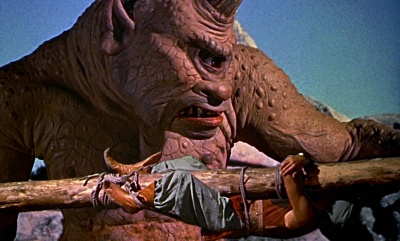 |
| [click to enlarge this shot from The 7th Voyage of Sinbad] |
The films these wide-eyed kids would go onto create years later would require staggering budgets and teams of dozens upon dozens of specialized technicians and artists. Their inspiration, though, was a man who'd rent out an old storefront, settle in for nine months at a time, and bring the bizarre and fantastic creatures of his imagination to life with nothing but his own two hands. Harryhausen's creations are magical, infused with the sort of character and personality that even the most talented animators in Hollywood would struggle to capture, and even though the films featured in this boxed set are fifty years old, they still inspire the same wide-eyed sense of wonder they did a lifetime ago.
This set features four of Ray Harryhausen's most iconic movies from the 1950s. One of them, 20 Million Miles to Earth, was released on its own Blu-ray disc late last year, and The 7th Voyage of Sinbad is getting its own separate high definition release alongside this collection. The other two movies -- It Came from Beneath the Sea and Earth vs. the Flying Saucers -- are currently exclusive to this boxed set. All four discs are lavish special editions, featuring in total around twelve hours of extras. Also, the three movies in this collection that Harryhausen was originally forced to shoot in black and white half a century ago have been colorized under his supervision, and these Blu-ray discs offer viewers the choice between the original photography and the newly colored versions, both in sparkling high definition.
20 Million Miles to Earth (1957)
Mamma mia! All Pepe (Bart Bradley) really wants is a cowboy hat, but when the Americans' first expedition to Venus crashes into the ocean outside the young boy's sleepy village in Italy, he stumbles upon something else entirely: some sort of slimy cocoon in an enormous test tube. Thinking he can at least milk a few bucks out of his discovery, Pepe sells it to a visiting professor (Frank Puglia) and his daughter (Joan Taylor). It turns out there's a creature lurking inside: a tiny Ymir that grows bigger and bigger with each breath it takes. It's not an evil critter, no, but being tossed in a cage and constantly under attack sets him off, so the Ymir does what any oversized monster in its position would: it goes on a rampage. Can Colonel Calder (William Hopper), the lone survivor of the trip to Venus, take the creature alive, or will the Italians have to gun it down before it kills again?
Anyone who's ever read up on Ray Harryhausen knows that King Kong was the movie that inspired him to carry on the art of stop motion animation, and quite a bit of Kong's influence is on display here. The Ymir is disoriented and only attacks out of fear, and it's the most sympathetic of the creatures in this Blu-ray set. Harryhausen's design is strange and exotic enough to look like a menacing alien beast, but it's so expressive and has such humanlike gestures and movements that it is imbued with a sort of humanity. The military and screaming bystanders only look at the Ymir long enough to see a monster; we, on the other hand, are able to see it for the tormented creature that it is. Like Kong before it, the Ymir doesn't hesitate to fight back when provoked, brawling in the streets of Rome with an escaped elephant and squaring off with the might of the military against the backdrop of the Coliseum.
Harryhausen's exceptional creature effects are framed around a simple, familiar vintage sci-fi story, complete with a clunky romance, a precocious kid sidekick, a gaggle of scientists, and chest-puffing military might to swoop in and save the day. If the Ymir had been played by a guy in a rubber suit, 20 Million Miles to Earth would be cute but forgettable...not all that different from a couple hundred other sci-fi flicks wading through the same stock formula. Harryhausen's dazzling effects elevate it into something much greater, and the Ymir stands out as one of the most memorable and best-realized creatures the genre had to offer in the '50s.
The 7th Voyage of Sinbad (1958)
With I guess six voyages
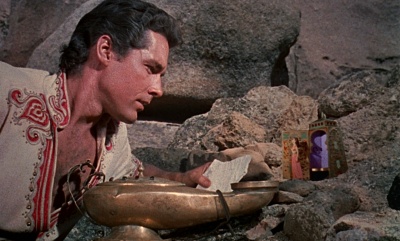 |
| [click to enlarge this shot from The 7th Voyage of Sinbad] |
I adore this movie more than I could ever hope put into words. There's a wide-eyed sense of adventure...of childlike awe...in every frame of The 7th Voyage of Sinbad. There's always something fascinating on the screen, without any meandering exposition or filler to bog down the runtime. No, the film just breezes from one sumptuous effects sequence to another: a cartwheeling genie hammering out a force field, a fire-breathing dragon, a horned Cyclops with a nasty disposition and a hefty appetite, a four-armed serpentine dancer, a pint-sized princess, a pair of colossal two-headed birds, and a dazzlingly choreographed sword fight with a skeleton that hints at what Harryhausen would accomplish a few years later with Jason and the Argonauts, and it's all punctuated by one of Bernard Herrmann's most memorable scores. There's a scale and ambition to The 7th Voyage of Sinbad that's rarely been matched even after fifty years. Sure, there are plenty of plot points to poke holes in, and although Kerwin Mathews is likable as Sinbad, he doesn't have the charisma or swashbuckling skills of an Errol Flynn. None of that really matters, though. The 7th Voyage of Sinbad is an endlessly thrilling adventure that rekindles a sense of awe and wonder I've hardly ever felt since I was a kid, and this visual spectacle is a showcase for the boundless imagination and enormous talents of Ray Harryhausen.
It Came from Beneath the Sea (1955)
Oh, it starts off as just another day on the submarine. Eat. Sleep. Press a button or yank a lever every once in a while. Thanks, Modern Science! The only thing these Navy men have to fret about is what music to blare over the loudspeakers, and as they're trying to pin down something a little more salty...WHAM! Commander Pete Mathews (Kenneth Tobey) doesn't know what hit 'em, but it left a calling card: some sort of radioactive gunk caking the sides of the sub. A couple of the nation's most skilled biologists are called in, and, yeah, one of 'em is a foxy woman (played by Faith Domergue), and...yup, there's a love triangle. The conclusion they come to is startling if you haven't already seen the poster: it's a giant octopus! Don't worry, though...the Navy's on the case. They pin down the creature's location to just off the San Francisco Bay, and if their depth charges and jet-propelled harpoon-torpedo don't knock off this
After two movies with such dazzling effects practically from start to finish, it's a little odd settling into It Came from Beneath the Sea. Of course, it was the success of these earlier movies that would give Harryhausen the time and resources he needed to be that ambitious, but it's very slow in coming here. Harryhausen's octopus animation isn't even glimpsed until a third of the way in, and it's another 20 minutes until the second on-screen attack. Both of those are really only brief glimpses as well, and with so much of the movie anchored around people standing around and talking, the movie seems glacial even with its lean 79 minute runtime. It's not until the last 20 minutes that all hell really starts breaking loose, and once the octopus wraps San Francisco in a chokehold, that plodding build-up seems completely worth it: the tentacles tearing down the Golden Gate Bridge, the beast trudging its way through the streets of downtown San Francisco, squaring off against soldiers packing flamethrowers... It's a ridiculous amount of fun. Harryhausen's creature animation isn't quite as fluid his later work, though, and the submarine model almost looks like a bathtub toy. I didn't buy into the romance that devours most of the movie's barely-feature-length runtime, but at least having familiar faces like Kenneth Tobey (The Thing from Another World) and Faith Domergue (This Island Earth) in front of the camera reminded me I was watching a science fiction flick. It Came from Beneath the Sea is my least favorite of the four films in this boxed set, but the havoc wreaked in its last 20 minutes make the slow, slow buildup seem worth it.
Earth vs. the Flying Saucers (1956)
It Came from Beneath the Sea may have waited until twentysomething minutes into the movie before we see a giant tentacle start to flail around, but Harryhausen's followup, Earth vs. the Flying Saucers, has a spaceship screaming across the screen within its first thirty seconds!
Dr. Russell Marvin (The Day the Earth Stood Still's Hugh Marlowe) has just swapped "I do"s with his assistant (Joan Taylor), but there's no time for a honeymoon: these newlyweds have a date with a three-stage rocket. On the drive out to Project Skyhook's base in the desert, though, a flying saucer swoops behind their car, and its eerie sounds are captured on the good doctor's portable recorder. The Marvins try to forget all about it, but something's shooting down the series of rockets that he's launching in the air, and...wait, could this be connected with the saucer? With the strange circular lights peppering the night sky? Well, this is a movie with "versus" in the title, after all, and following a colossally destructive assault on the military rocket installation, the aliens demand a meeting with Earth's leaders in Washington. Our missiles are useless, so how can we fight back? The clock is ticking down with just 56 days to go, and maybe -- just maybe -- that's all the time we need to build a new weapon and stave off a massive attack on our nation's capitol.
Earth vs. the Flying Saucers lives up to its title: alien spacecraft pop up every few minutes with an arsenal of force fields, disintegrating death rays, and the infinitely indexed memory bank that zombifies humans and tips the invaders off about just what our little blue mudball is capable of. Creatures trashing legendary landmarks is a Harryhausen staple, and the saucers really do a number on D.C., toppling the Washington Monument and taking the top off the Capitol Building. The design of the ships is sleek and deceptively simple, with the whirring gyros and precise camerawork setting these saucers apart from many '50s sci-fi flicks. There's a much more convincing sense of motion and power, worlds removed from pie pans dangling from strings. The design of the aliens' stiff, blank suits once they step outside of their saucers doesn't hold up all that well fifty years later, but the makeup when one fallen alien is unmasked looks pretty great, and the helmet that's leftover makes for one of the most cacklingly ridiculous shots in the movie as Dr. Marvin decides to try it on. This isn't a taut, fingernail-biting story, no, but there's no shortage of action, I felt drawn into the story enough to want to see it through, and the movie's a lot of fun.
Video: Ray Harryhausen would've filmed all of his movies in color if it were possible, but lean budgets and technical hiccups with color stock meant he frequently had to
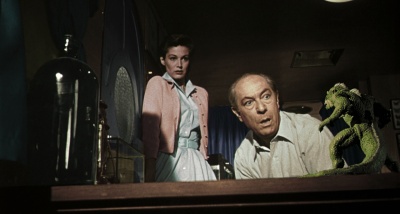 |
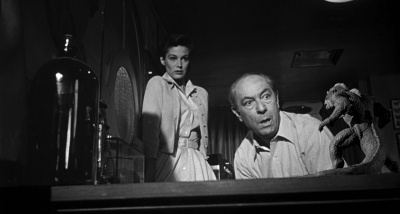 |
| [click to enlarge either of these shots from 20 Million Miles to Earth] |
The three black and white films are a bit uneven, and not just because of the sometimes dodgy stock footage. Crisp, clear, and nicely detailed, 20 Million Miles to Earth looks the best by far, and It Came from Beneath the Sea ranks a fairly close second. Earth vs. the Flying Saucers is a bit of a disappointment, though; it's excessively soft, and edges frequently look fuzzy and not all that well-defined. Of the movies in this collection, that's the most modest step up over the DVD. The grainy texture of these movies has been retained, although the grain tends to look muddied and clumped together in Earth vs. the Flying Saucers. A few tiny flecks of dust creep in, but the wear is pretty easily shrugged off.
The 7th Voyage of Sinbad is the only of these films to have originally been shot in Technicolor, and the limitations Harryhausen mentions with tackling Dynamation in color do creep in. The image is soft and extremely grainy, and the traveling mattes don't blend nearly as convincingly in color as they do in black and white. Still, the film grain is rendered flawlessly, and I couldn't spot any wear or speckling at all. The 7th Voyage of Sinbad isn't one of the more technically striking classic films I've watched on Blu-ray -- not in the same league as, say, The Adventures of Robin Hood or Black Narcissus -- but it is a jaw-droppingly beautiful, visually arresting movie that screams out to be experienced in high definition.
Unlike the cropped DVD from the better part of a decade ago, The 7th Voyage of Sinbad is lightly pillarboxed here to an aspect ratio of 1.66:1. It Came from Beneath the Sea, 20 Million Miles to Earth, and Earth vs. the Flying Saucers are all presented at 1.85:1. Like virtually everything from Sony these days, all four of these films have been encoded with AVC.
Audio: All four of the films in this boxed set have been remixed to 5.1, and these 16-bit Dolby TrueHD tracks sound pretty terrific. These aren't awkward, gimmicky remixes, and they're pretty faithful to the original monaural audio. The action generally stays rooted up front -- even as the Ymir carves a path of destruction through Rome -- with the surrounds reserved for fleshing out a remarkably convincing sense of atmosphere.
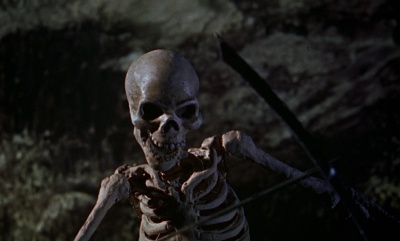 |
| [click to enlarge this shot from The 7th Voyage of Sinbad] |
The low-end tends to be pretty light, not that Hollywood was really aiming for wall-rattling bass back in the mid-'50s. The explosions that litter Earth vs. the Flying Saucers are bolstered by a decent low-frequency kick, though, even if they sound kind of flat, and the havoc that closes out It Came from Beneath the Sea sounds fairly full-bodied too. The music throughout each film sounds rich and full, with Bernard Herrman's wonderful score for The 7th Voyage of Sinbad standing out as particularly impressive. Dialogue is generally rendered cleanly and clearly, although some moments are hit or miss, such as the strain audible in the opening stretch of It Came from Beneath the Sea. A few lines in The 7th Voyage of Sinbad have an off-kilter reverb to them, and there were one or two spots where I noticed lips moving but no dialogue being delivered.
It kind of goes without saying that these soundtracks aren't as aggressive as a modern sci-fi or fantasy flick, but these are solid remixes, and it's appreciated that Sony did go to the effort of including lossless tracks for each of them.
The other audio options vary by title. The 7th Voyage of Sinbad is the only movie in the set to include the original monaural soundtrack, and that disc also features a TrueHD 5.1 French track along with a Thai dub. Earth vs. the Flying Saucers is also dubbed into French, 20 Million Miles to Earth offers a mono track in Spanish, and It Came from Beneath the Sea doesn't feature any dubs. All of the films in this boxed set serve up a fairly extensive selection of subtitles, although the selection varies from disc to disc.
Extras: All four of the movies in this boxed set are impressively loaded special editions, although some of the same extras are recycled from one disc to the next. None of them, somewhat disappointingly, are in high definition, although the quality and sheer volume of material still make for some essential viewing. There really isn't any filler in here at all, and I found every last extra in this set -- twelve hours' worth in total! -- well worth taking the time to watch.
There are a couple of common threads
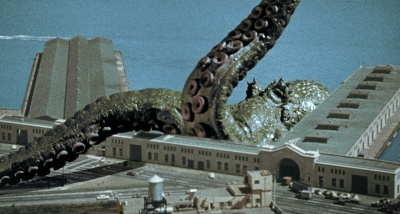 |
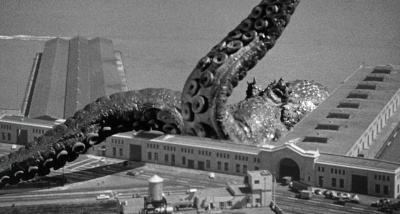 |
| [click to enlarge either of these shots from It Came from Beneath the Sea] |
On 20 Million Miles to Earth, Harryhausen and Kunert are joined by Dennis Muren and Phil Tippett, ILM alums whose credits date back to Star Wars. Tippett and Muren play the role of moderators as they enthusiastically bombard Harryhausen with questions about his process, including character designs, fabrication, the number and the size of his models, how he captured a sense of weight and motion, and how he guided the actors' eyelines. Other topics include the colorization process, how Harryhausen preferred to work in isolation, and how 20 Million Miles to Earth marked the first independent production between him and Charles Schneer.
Tippett returns with Harryhausen and Kunert to sit in on the commentary for The 7th Voyage of Sinbad, which also features Randall William Cook (Lord of the Rings) and Bernard Herrmann biographer Steven Smith. This is by far my favorite of the four commentary tracks in this boxed set. Again, Harryhausen fields questions from the the visual effects artists about his techniques, including his first time working with foam-rubber injections, dealing with the down on the colossal baby roc, and -- gasp! -- the total lack of studio meddling. Some of the other topics include Columbia promoting the film with preproduction art months in advance of its release, the syrens that Harryhausen didn't have the time or budget to add into the movie, costumes nicked from a Rita Hayworth project that never got off the ground, and even laughing about some of the goofy conveniences in the storytelling. Steven Smith contributes a half-hour discussion about Bernard Herrmann elsewhere on this Blu-ray disc, but he expands on many of those points in considerably greater detail here.
The visual effects artists featured in the commentary for Earth vs. the Flying Saucers are Ken Ralston (another Star Wars alum), and Jeffrey Okun (who, appropriately enough, is working on the remake of The Day the Earth Stood Still). The two of them prompt Harryhausen to reveal a couple of his secrets, including how the saucers' shadows were animated, creating death rays out of cotton, wire, and fireworks, the disturbing source of the sound of the saucers in flight, and how this movie might've looked a lot different if not for the hardware department at Sears. Among the other highlights are the timeline of when Harryhausen first conceived the ideas behind many of his films, rants about the lack of discipline in modern day Hollywood (including some not-so-subtle jabs at Peter Jackson's King Kong remake), and how during the filming of It Came from Beneath the Sea, the city of San Francisco was concerned the movie would cause people to lose confidence in the integrity of the bridge...y'know, if it were attacked by a real-life atomically irradiated octopus, I guess.
For the last of the set's audio commentaries, Cook, Harryhausen, and Kunert are joined by John Bruno, another Academy Award winning effects wizard out of ILM. Harryhausen delves into the process of Dynamation in this commentary for It Came from Beneath the Sea in more depth than he does in any of the other extras in this set, and he also explains his compositing and diffusing techniques as well as how he handled wire removal in these dark days before computers were added to the arsenal. Harryhausen also describes the fairly small size of the models, what color he originally envisioned for the creature, and how the studio was hoping for the sort of cartoonish octopus they'd seen on "Popeye".
Along with these commentaries, all four movies also include lengthy retrospectives. "Remembering 20 Million Miles to Earth" (26 min.) features Ray Harryhausen, of course, along with Terry Gilliam, John Canemaker, Rick Baker, the Chiodo Bros., Stan Winston, and John Landis. Some of the topics include how the movie is set in Italy just because Harryhausen wanted a free trip to Europe, how the design of the Ymir evolved dramatically over time, giving the character a more expressive, anthropomorphic appearance, how settling for a tiny elephant meant an equally tiny attendant had to be cast, and drawing comparisons of this film to both E.T. and King Kong.
"Remembering It Came from Beneath the Sea" (21 min.) opens by noting how the image of a giant octopus tearing apart the Golden Gate Bridge that producer Charles Schneer couldn't get out of his head was the start of a very long collaboration. Harryhausen also discusses the documentary-like approach he wanted to take for the film, trying to capture a sense of motion underwater, shooting portions of the movie inside an actual submarine, and laughing about how the lean budget meant he had to pare his octopus down to just six tentacles. Harryhausen shows off one of the models used as part of the creature's reign of terror in San Francisco, and effects artist John Bruno laughs about having to drive over the Golden Gate Bridge on his way back from seeing It Came from Beneath the Sea as a tyke.
One of the highlights of "Remembering Earth vs. the Flying Saucers" (21 min.) is Harryhausen demonstrating how he conveyed the intelligence and character of these alien invaders with some of the actual saucers from the movie. He also talks about animating the pedestal and gun on one of the ships, the different models that were used throughout the shoot, and how some leftover footage of the saucers would be recycled in several other movies, including Orson Welles' F for Fake. Other topics include the extensive and clever use of stock footage, the design of the suit, a look at several conceptual sketches, and animating the destruction of the capitol.
"Remembering The 7th Voyage of Sinbad" (23 min.) is the last of these retrospectives, and it covers the long process of getting this film off the ground, the exotic backdrop that Harryhausen originally envisioned, the oversized props made to sell the tiny size of the shrunken princess, how the Cyclops was considered so terrifying that much of his screentime was snipped out in the UK, and the meticulous choreography of the swordfight. There are quite a few other technical notes, including the trickiness of dealing with color stock for the first time, how he made the dragon breathe as well as spew out fire, and repurposing the skeleton of 20 Million Miles to Earth for one Cyclops. Harryhausen also shows off the original skeleton used for the swordfight, and it looks practically as good as new.
The 7th Voyage of Sinbad features a second retrospective as well. "A Look Behind the Voyage" (12 min.) is a vintage featurette that dates back a few decades, and it's the only extra on this boxed set to feature Charles Schneer, Harryhausen's longtime producer. "A Look Behind the Voyage" opens by touching on what led Harryhausen to dive into a life based around stop motion animation, and from there, it explores the
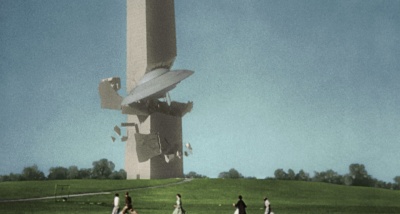 |
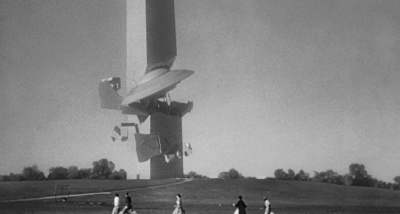 |
| [click to enlarge either of these shots from Earth vs. the Flying Saucers] |
"This is Dynamation" (3 min.) is another vintage featurette on The 7th Voyage of Sinbad, and this one dates back from before the film was even released. It delves into Harryhausen's process, and one highlight is seeing the different elements used in bringing several of the movie's most memorable scenes to life, from the raw footage of Princess Parisa shrinking to Kerwin Mathews swordfighting with his Italian instructor on the set. This is one of the shortest extras on the entire four disc set, but for Harryhausen's most rabid fans, "This is Dynamation" may be one of the most intriguing.
"The Harryhausen Legacy" (25 min.) revolves around a slew of effects artists, film historians, and directors who are still wide-eyed about the impact The 7th Voyage of Sinbad made on their lives. They point out some of their favorite moments in the film, note how some of Harryhausen's enduring images have embedded themselves in the public consciousness, and why Harryhausen's work transcends the expected role of a visual effects artist.
Even with as vivid and iconic as Harryhausen's creations are, The 7th Voyage of Sinbad wouldn't be nearly the movie it is without Bernard Herrmann's infectious fantasy score. Herrmann biographer Steven C. Smith speaks for nearly half an hour about the composer, from his childhood, his radio work with CBS, his later collaborations with Harryhausen, and the final years of his life. The focus is primarily on The 7th Voyage of Sinbad, though, and Smith delves into the clever instrumentation in several key sequences, the way Herrmann acknowledges previous Arabian fantasy scores, and how the composer's longstanding fascination with the genre influenced his work here.
The name Mischa Bakaleinikoff doesn't carry nearly the same marquee value as Bernard Herrmann, but David Schecter does what he can to change that with "Film Music's Unsung Hero" (22 min.). This extremely comprehensive featurette explores how Bakaleinikoff dusted off music from Columbia's library and occasionally contributed his own work to piece together the scores for the studio's B-unit. This featurette is so thorough that it highlights which movies certain cues were recycled from, who the original composers were, and why a certain piece of music was reused for a particular scene. Schecter touches upon how many different scores would be nicked from the library for a single movie -- 95 cues from 18 different composers in the case of 20 Million Miles to Earth, versus the usual 25 to 30 cues -- along with Bakaleinikoff's fascination with a four note theme that'd swell in size throughout the movie in the same way the Ymir itself grew and grew. "Film Music's Unsung Hero" is featured on both 20 Million Miles to Earth and It Came from Beneath the Sea.
The last of the music-themed extras is a music video for "Sinbad May Have Been Bad, But He's Been Good to Me". This goofy little ditty from a Colpix 45 plays over a set of posters of The 7th Voyage of Sinbad from around the world.
Still radiant half a century later, actress Joan Taylor is featured in her own 17 minute interview. This conversation focuses heavily on getting her start in Hollywood and runs through the entirety of her career, including -- of course! -- her starring roles in 20 Million Miles to Earth and Earth vs. the Flying Saucers. Naturally, this interview is included on both of those discs.
Harryhausen himself is interviewed a couple of times throughout the set. The first is a conversation with Tim Burton (27 min.), who'd pay homage to one of Earth vs. the Flying Saucers' most iconic shots in Mars Attacks! Some of the topics include struggles with meager budgets and tight schedules, these recent colorizations of his films, how Harryhausen collaborated with writers and directors since he was the only one who knew what he was capable of creating in his workshop, infusing flying saucers with some sort of personality, and how he aimed for more of a family-oriented fantasy tone rather than traditional horror. Again, Harryhausen still has some of the original saucers handy to demonstrate his technique. Both Harryhausen and Burton are extremely enthusiastic and personable, and a slew of really great stories are lobbed out in this interview. This chat appears on both 20 Million Miles to Earth and It Came from Beneath the Sea.
John Landis' 1995 interview with Harryhausen (12 min.) is anchored around Jason and the Argonauts, although there's a reason it's included with The 7th Voyage of Sinbad: he has the swordfighting skeleton from that movie
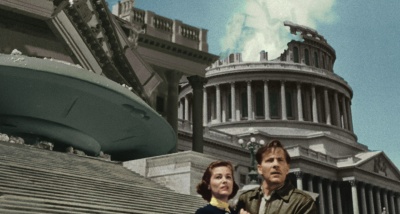 |
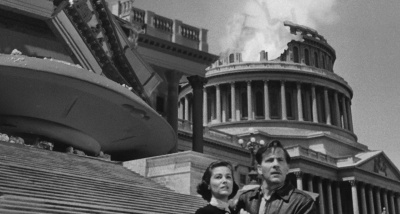 |
| [click to enlarge either of these shots from Earth vs. the Flying Saucers] |
"The Hollywood Blacklist and Bernard Gordon" (29 min.) is a detailed look into one of the most shameful periods in the history of Hollywood, set against the backdrop of the Red Scare and the particularly crushing effect it had on Earth vs. the Flying Saucers' screenwriter. Bernard Gordon had written that film -- along with Hell of the Navy (which, incidentally, starred Ronald Reagan and his future first lady), Day of the Triffids, and Battle of the Bulge, among others -- under a pseudonym at a fraction of the going rate and without the protection of the Writer's Guild. The featurette also delves into how the blacklist affected other writers, such as Dalton Trumbo and Michael Wilson, along with some discussion about how this terrible period in Hollywood whimpered to an end and the steps the WGA took in order to reinstate nearly a hundred films' true writing credits.
Although the movie proper reinstates Gordon's screenwriting credit, the original 1956 credit sequence for Earth vs. the Flying Saucers under the pseudonym "Raymond T. Marcus" is included as an extra.
"The Colorization Process" (11 min.) features Harryhausen and the crew at Legend Films running through how these three black and white movies were infused with color for the first time, along with brief notes about the digital remastering. This featurette appears on both 20 Million Miles to Earth and Earth vs. the Flying Saucers.
It Came from Beneath the Sea includes "A Present Day Look at Stop Motion" (11 min.), which follows film student Kyle Anderson through every step of the process: from armitures and plaster casts all the way to animating his homemade characters one frame at a time. While his characters aren't in the same league as Harryhausen's, many of the techniques Anderson demonstrates are fundamentally the same, and it's interesting to see them as they're put to use.
Each disc features a set of photo montages. 20 Million Miles to Earth cycles through 11 minutes' worth of production stills and Harryhausen's conceptual sketches, It Came from Beneath the Sea includes a full half hour of conceptual art, stills, and posters from across the globe, Earth vs. the Flying Saucers features 23 minutes of advertising art and photos from the set, and The 7th Voyage of Sinbad is the leanest with just 11 minutes of production stills.
The art of advertising in the '50s is highlighted in a 17 minute featurette, showing off press books, lobby cards, vintage newspaper ads, international poster art, and one-sheet, three-sheet, and even six-sheet posters, along with some art created by individual theaters. Instead of just cycling through scans of each piece of artwork, they're physically introduced, and the discussion swirls around how ineffectively some of Harryhausen's movies seem to have been promoted, how many advertising options each theater had at its fingertips, and even how movies were starting to be plugged on that newfangled medium of television. This advertising featurette is included on both 20 Million Miles to Earth and It Came from Beneath the Sea, and advertising for all four of the movies in this set are explored in a pretty impressive amount of detail.
BlueWater Press has published comic book followups to several of the movies featured in this set, and each disc includes a preview of those comic sequels: "Flying Saucers vs. the Earth", "20 Million Miles More", and "It Came from Beneath the Sea Again". First the entire page is shown, and then half of each page is blown up to show off the dialogue and detailed artwork. These previews tend to run five or six pages a piece.
It Came from Beneath the Sea and Earth vs. the Flying Saucers each feature a trailer gallery, and between them, there are trailers for all of the movies in this set. They're encoded in high definition but look upscaled to my eyes.
20 Million Miles to Earth is a repackaging of the Blu-ray disc released late last year, and it's the only of the four discs in this set to not feature the BD Live functionality that's since become standard for Sony.
Each of these movies is packaged in a traditional Blu-ray case, and they're collected in a thin cardboard sleeve.
Conclusion: Ray Harryhausen is one of the single greatest craftsmen in the history of cinema. The movies he made endure the way they do thanks to his skill at infusing these characters -- even if they're whirring flying saucers or a tentacle writhing out of the San Francisco Bay -- with a personality and life that teams of animators and tens of millions of dollars of computing power are still struggling to match. Even half a century later, Harryhausen's movies continue to inspire a sense of awe and childlike wonder like very few I've seen, and the four films featured in this boxed set are among his most iconic. Even though the scripts and performances don't entirely live up to Harryhausen's creations, it's an enormous thrill to be able to experience these movies in sparkling high definition, and fans of his can look forward to many, many hours of extras to explore. Very, very Highly Recommended.
Related Reviews: DVD Talk has also reviewed the individual Blu-ray releases of 20 Million Miles to Earth and The 7th Voyage of Sinbad, both of which are available separately from this boxed set.
|
| Popular Reviews |
| Sponsored Links |
|
|
| Sponsored Links |
|
|
| Release List | Reviews | Shop | Newsletter | Forum | DVD Giveaways | Blu-Ray | Advertise |
|
Copyright 2024 DVDTalk.com All Rights Reserved. Legal Info, Privacy Policy, Terms of Use,
Manage Preferences,
Your Privacy Choices | |||||||









